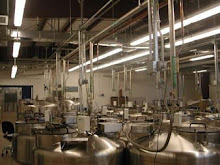Odd reports have always swarmed around the Hall of Fame baseball slugger Ted Williams and the cryonic freezing of his head and body cryogenic storage containers.
Apparently Williams' head and body are still being stored in an Arizona cryonics lab. Williams' son, John Henry Williams, had is father placed in cryonic suspension, a process that freezes body parts in hopes that future scientific advancements will restore the dead to life or clone the person.
http://www.blogger.com/img/blank.gif
Oddly enough, reports have stated that Williams head has been separated from the body and put in different cryogenic storage containers. The two are in the same room, but Williams' head was placed in a liquid nitrogen-filled steel cryogenic storage can on a shelf, while his body is in the same room. The body is in a liquid-nitrogen-filled, nine-foot-tall cylindrical steel tank and is properly marked by his ID number, A-1949.
The bizarre part of the post-mortem drama is that this may have not been Williams' intentions. Instead, it appears his son wanted the process to be done. The only publically known documentation that suggested Williams wanted to be perceive was on a piece of scrap paper, which was stained with motor oil and was dated Nov. 2, 2000. The paper bares Williams, John Henry and his sister Claudia signatures stating to be put in "Bio-Stasis after we die."
Williams' body was flown to Arizona almost immediately after his death on July 5, 2002. Many people contend that John Henry wants to preserve his father's DNA or even sell it. The saga is certainly interesting considered the potential of cryonics thanks to cryogenic storage. Could you imagine seeing Ted Williams in his baseball gear again? Now that would be something!
Friday, April 13, 2012
Tuesday, April 10, 2012
Can Future Cryonic Technology Reanimate Life?
Is there a way for us humans to shed our mortality? Well, some have the idea of using cryogenic storage to preserve our bodies beyond death in the hope that science will find the secret to everlasting life.
While most Americans choose the traditional path of being buried or cremated following death, there is an alternative to this type of treatment. With cryonics, the storage system can preserve a recently deceased or a seriously diseased person in the hopes that one day scientists will figure out how to reanimate to cure afflictions such as a terminal illness. These cryonic patients, called cryonauts, place their trust in the scientific advancement of the future. That trust and risk may pay out at a chance of immortality. This may sound more like science fiction rather than founded science, but many foresee the possibility of reanimation in the future, either near or distant.
The scientific concern with cryogenic storage regards tends to deal with the formation of ice crystals in the patient's cells while the body is cooled to a chilly -200 degrees Celsius. Antifreeze solution is used to reduce the formation of these ice crystals, but they occur nonetheless and cause serious tissue damage – much like freezer burn. Although, scientists feel that there will eventually be a way to repair this damage or even prevent it for future cryonauts.
For proof of escalating technology, cryobiologists have found a new technology called vitrification, which allows preservation without damaging tissue. Cryogenic vitrification involves replacing the patient's blood with a unique antifreeze cocktail that prohibits ice formations and suspends cells in a glass-like state. However, vitrification has only been achieved with single human cells and not an entire body; but is this opening a path to future solutions.
At this point, cryogenic storage for bodies is putting a lot of stock in future science. While it seems very fictional and fanciful, just think of how many people 200 years ago would laugh at the idea of a flying Boeing 747?
While most Americans choose the traditional path of being buried or cremated following death, there is an alternative to this type of treatment. With cryonics, the storage system can preserve a recently deceased or a seriously diseased person in the hopes that one day scientists will figure out how to reanimate to cure afflictions such as a terminal illness. These cryonic patients, called cryonauts, place their trust in the scientific advancement of the future. That trust and risk may pay out at a chance of immortality. This may sound more like science fiction rather than founded science, but many foresee the possibility of reanimation in the future, either near or distant.
The scientific concern with cryogenic storage regards tends to deal with the formation of ice crystals in the patient's cells while the body is cooled to a chilly -200 degrees Celsius. Antifreeze solution is used to reduce the formation of these ice crystals, but they occur nonetheless and cause serious tissue damage – much like freezer burn. Although, scientists feel that there will eventually be a way to repair this damage or even prevent it for future cryonauts.
For proof of escalating technology, cryobiologists have found a new technology called vitrification, which allows preservation without damaging tissue. Cryogenic vitrification involves replacing the patient's blood with a unique antifreeze cocktail that prohibits ice formations and suspends cells in a glass-like state. However, vitrification has only been achieved with single human cells and not an entire body; but is this opening a path to future solutions.
At this point, cryogenic storage for bodies is putting a lot of stock in future science. While it seems very fictional and fanciful, just think of how many people 200 years ago would laugh at the idea of a flying Boeing 747?
Subscribe to:
Comments (Atom)
